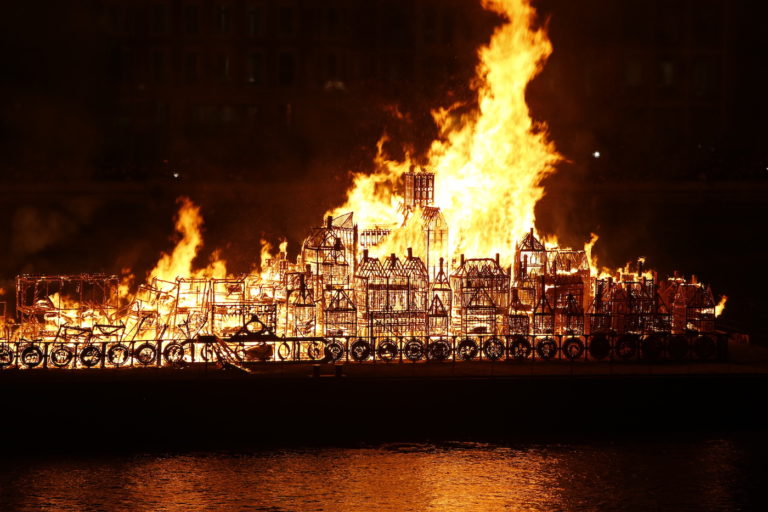London’s burning–again. But this time, it’s not The Clash’s doing.
On September 5, a gigantic wooden model of the city of London as it might have appeared in 1666 was burned atop several barges in the Thames River to commemorate the 350th anniversary of the Great Fire of London.

London 1666 was created by David Best (of Burning Man fame) for the London’s Burning festival. According to Hyperallergic, Best undertook the creation of the project in collaboration with the Artichoke Trust. The San Franciscan artist and volunteers built the 390-foot-long structure, which Best calls an imaginative construction of a representation of the city’s skyline in the seventeenth century.
Best’s work came to the attention of Helen Marriage, the director of the British company Artichoke, after his work on a secular “temple” for bonfires in (London) Derry, Northern Ireland.* As Artichoke was putting on the Great Fire 350 festival in London–a reimagining of the Great Fire through the eyes of “contemporary artists, writers, and thinkers”–Best seemed like just the person to go to for an installation piece.

According to the BBC and the Visit London website, fire broke out at a bakery in London’s Pudding Lane on September 2, 1666. It grew to engulf the eight percent of the city that lay within the city walls over three days. While only six deaths were reported, 13,200 homes were destroyed and between 65,000 and 70,000 people were left homeless. The BBC states that hundreds of thousands of Londoners camped out in shanty towns across the city, calling to mind various housing crises of the thousands of refugees pouring into European cities from conflicts across the world.
The fire, though catastrophic, is now somewhat seen as the end of a chapter in the city’s history that could be entitled “Medieval London.” With a good percentage of the city destroyed, Londoners rapidly rebuilt the city as the “modern metropolis” we know today.
The burn was staged on September 5, the day that the fire finally died out 350 years ago. Best’s imaginative wooden structures were floated out onto several barges on the Thames River–the biggest open space safe to burn things in the city, as well as the one that would make the installation the most dramatic.
Which, it looks like from photos, it most certainly was.
Want to watch it burn, baby, burn? There are more videos and links on the BBC Arts’ page. Disclaimer–some may or may not be available in the US and the BBC iPlayer can be notoriously finicky. There’s also some lovely visual guides to the fire’s historicity in this Telegraph article.
Or just check out 49 minutes’ worth of footage from Visit London here.
*Referred to as Derry by the Irish and Londonderry by the British, respectively. It just goes to show how amazing it is that Best could construct a project free from both politics and religion there that enjoyed the success it did.
Are we pyrotechnicians at the Art Docent Program? Of course not! Find out more about what we do and our educational program here.
Need another art blog to follow? Check out past blog posts here!







